This article was co-authored by Chris M. Matsko, MD. Dr. Chris M. Matsko is a retired physician based in Pittsburgh, Pennsylvania. With over 25 years of medical research experience, Dr. Matsko was awarded the Pittsburgh Cornell University Leadership Award for Excellence. He holds a BS in Nutritional Science from Cornell University and an MD from the Temple University School of Medicine in 2007. Dr. Matsko earned a Research Writing Certification from the American Medical Writers Association (AMWA) in 2016 and a Medical Writing & Editing Certification from the University of Chicago in 2017.
This article has been viewed 964,327 times.
When your nose becomes congested, it can become difficult to breathe properly. Luckily, you can breathe easy again by cleaning your nostrils with a nasal spray or a nasal wash.
Steps
Using a Nasal Wash
-
1Buy a nasal wash kit with salt solution or make your own solution. Nasal washes are good for relieving nasal symptoms if you have chronic nasal issues or sinus problems. Washing the inside of your nose with a salt solution will reduce swelling, improve airflow, and open up your sinus passages. It will also remove mucus from your nose and help to relieve any stuffiness or congestion. Look for nasal wash kits at your local pharmacy or make your own salt solution using household products.
- To make your own saline solution, combine 1 quart distilled water, 1 teaspoon Kosher salt and ½ teaspoon baking soda in a clean glass jar. Stir the solution and store at room temperature. Replace the solution after a week with fresh water, salt, and baking soda.
- Do not use tap water. If you don't have distilled water you can sterilize tap water by boiling it for at least one minute, then allowing it to cool back down to room temperature. This will kill harmful contaminates.[1]
-
2Use a bulb syringe or a neti pot. In order to rinse your nose effectively with the salt solution, you will need a bulb syringe or a neti pot, which is a tea pot with a long spout made for your nose. You can find bulb syringes and neti pots at your local drugstore or pharmacy.
- Wash your hands well before you do a nasal rinse to prevent the spread of bacteria and germs. Then, fill the bulb syringe or neti pot with the saline solution.
Advertisement -
3Stand over the sink or over a bath tub. When you are using the nasal wash, you will need to stand over an area that can collect any water or mucus that drips from your nose or from the bulb syringe.
- Place the bulb syringe in your left nostril and gently squirt the mixture into your left nostril. Aim the stream toward the back of your head, not the top of your head. Do not inhale through your nose as you squirt. The bulb syringe should be able to get the solution into your nose without any inhalation on your part.
- If you are using a neti pot, place the spout in your left nostril and tip the pot up so the solution enters your nose. If the solution does not flow out of the neti pot, lift the pot so it is positioned a bit higher than your head but do not turn your head over your shoulder. Try to keep your forehead above your chin.
-
4Tilt your head forward with your chin to your chest. This will allow excess solution to drain out of your nose into the sink or bath tub. You can hold a wash cloth under your chin to help collect any excess solution. Do not swallow the solution if it gets in your mouth. Spit it out into the sink or tub.[2]
- After you have cleared out your left nostril, you may should rotate your head so you are facing the sink or tub and exhale sharply through both nostrils. This will help to remove any excess mucus or water. You can also use a tissue to wipe off any excess mucus or water. However, do not press down on one nostril while blowing through the other nostril, this can put pressure on your inner ear canal.
- Repeat the same process with your right nostril using the bulb syringe or the neti pot and the salt solution.
-
5Alternate nostrils several times until you run out of solution. There may be a mild burning sensation in your nose when you use the nasal wash for the first several times. This is a normal reaction to the salt in the solution and should become less noticeable with repeated use of the nasal wash.
- If the solution continues to irritate your nose, it may not be salty enough or too salty. Taste the salt solution to determine if it too salty (you taste too much salt) or not salty enough (you can barely taste the salt). Adjust the solution so you can taste the salt but it is not an overpowering taste.
- If you develop a headache after using a nasal wash, your forehead may have been lower than your chin, leading to some water draining into your frontal sinus. After some time, the water should drain out on its own.
-
6Use the nasal wash at once a day in the morning or at night. If your symptoms become more severe or you develop a severe infection, increase the dose to twice a day.
- It can be difficult for your children to use a nasal wash. Assist your child when they are using the nasal wash and make sure they do not lie down when using the nasal wash. The nasal wash is more effective when done while sitting or standing.
Using Nasal Spray
-
1Look for over-the-counter nasal spray at your local pharmacy. If you are struggling with a stuffy, itchy, or runny nose due to hay fever or allergies to pollen, mold, dust, or pets, nasal spray should help to relieve your symptoms. You should not use nasal spray to treat symptoms of a flu or cold, as it will only provide temporary relief. Go see your doctor about other, more effective medications if you have nasal issues due to a flu or cold.[3]
- The most common type of over-the-counter nasal spray is Fluticasone nasal spray, which is in a class of medications called corticosteroids. Corticosteroids improve your nasal issues by preventing the release of natural substances that can cause allergy symptoms. They should only be used for chronic allergies.
- You can also use a nasal spray that contains xylitol, purified water, salt, and grapefruit seed extract. This type of nasal spray has no side effects and contains no drugs. It is also safe for all ages.[4]
-
2Use the recommended dosage on the nasal spray label. If you are using the spray as an adult, you will begin with a higher dose of the nasal spray and then decrease your dose as your symptoms improve. This is usually one spray in each nostril once a day, or one spray in each nostril twice a day (once in the morning, once at night) if your doctor recommends a higher dose for your symptoms. If you are giving the nasal spray to a child, begin the treatment with a lower dose and then increase the dose if the child’s symptoms do not get better.[5]
- Always follow the dose directions on the nasal spray label and ask your pharmacist to explain any instructions you do not understand. Never use more or less than specified on the package or as recommended by your pharmacist. If you miss a dose, do not double up on the dose. Instead, wait until the following day and continue on your recommended dose for the day.
- Children younger than four years old should not use nasal spray. Children younger than 12 years old should be assisted by an adult when using nasal spray.
- Only use nasal spray in your nose. Do not spray it in your eyes or mouth. As well, you should never share your nasal spray with someone else as this may spread germs and bacteria.
-
3Wash your hands well before using the nasal spray. Shake the nasal spray before each use. Then, remove the dust cover on the spray. If you are using the spray for the first time, you will need to prepare the pump so you can use it properly.[6]
- Hold the pump so your forefinger and middle finger grip the applicator and your thumb rests on the bottom of the bottle. Point the applicator so it if facing away from your face.
- Press down and release the pump six times. If you have used the pump previously, but not within the last week, press down and release the pump until it releases a fine spray.
-
4Blow your nose until your nostrils feel clear. If your nose is very stuffed up, this may be difficult to do. Do your best to clear your nose of mucus before you use the spray as this will ensure the spray enters your nose properly.[7]
-
5Seal one nostril with your finger. Tilt your head forward and place the nasal applicator tip into your other nostril. Keep the bottle upright so the spray releases properly. You should still be holding the applicator between your forefinger and your middle finger.[8]
- Breathe in through your nose. As you breathe in, use your forefinger and middle finger to press down on the applicator, releasing the spray into your nose.
- Once you have released the spray, breathe out through your mouth.
- If you have been instructed by your doctor to use two sprays in each nostril, repeat these steps again on the same nostril. If you are only using one spray in each nostril, repeat these steps again in the other nostril.
-
6Wipe the applicator with a clean tissue. It is important that you keep the applicator clean so you do not spread germs and bacteria in your nose when you use the spray. You should also keep the nasal spray covered with the dust cover to prevent tiny particles from getting into the spray.[9]
- Store the nasal spray in a dry spot at room temperature, not in your bathroom where the air can be humid and moist. If the applicator becomes clogged, you can soak it in warm water and rinse it with cold water. Dry it well and store it properly. Do not use pins or a sharp object to remove the blockage as this can contaminate the nasal spray.
-
7Be aware of the potential side effects of nasal spray. Always check the nasal spray label for a list of ingredients. If you think you may be allergic to fluticasone or any other ingredients in the spray, talk to your doctor or pharmacist. If you are on any antifungal medication or steroid medications, you should tell your doctor or pharmacist. You may need to adjust your dose or be monitored for side effects of the spray. If you experience any of the following side effects, you should stop taking the nasal spray and see your doctor immediately:[10]
- Headache, dizziness, nausea, diarrhea, or vomiting.
- Dryness, stinging, burning, or irritation in your nose.
- Bloody mucus in your nose, nosebleeds, or thick nasal discharge.
- Vision issues or severe face pain.
- Fever, chills, coughing, sore throat, or other signs of an infection.
- Hives, a rash, or severe itching.
- A whistling sound from your nose.
- Swelling of your face, throat, lips, eyes, tongue, eyes, hands, feet, ankles or lower legs.
- Hoarseness, wheezing, or difficulty breathing or swallowing.
- If you have had surgery on your nose in the past month or injured your nose, you should go see your doctor before using nasal spray. As well, if you have sores on your nose or any eye issues, you should talk to your doctor before using any medications for your nose.
Expert Q&A
Did you know you can get expert answers for this article?
Unlock expert answers by supporting wikiHow
-
QuestionHow long do I hold the solution in my nasal cavity?
 Daniel Wozniczka, MD, MPHDr. Wozniczka is an Internal Medicine Physician, who is focused on the intersection of medicine, economics, and policy. He has global healthcare experience in Sub Saharan Africa, Eastern Europe, and Southeast Asia. He serves currently as a Lieutenant Commander in the U.S. Public Health Service and a Medical Officer for the Epidemic Intelligence Service in the CDC. He completed his MD at Jagiellonian University in 2014, and also holds an MBA and Masters in Public Health from the University of Illinois at Chicago.
Daniel Wozniczka, MD, MPHDr. Wozniczka is an Internal Medicine Physician, who is focused on the intersection of medicine, economics, and policy. He has global healthcare experience in Sub Saharan Africa, Eastern Europe, and Southeast Asia. He serves currently as a Lieutenant Commander in the U.S. Public Health Service and a Medical Officer for the Epidemic Intelligence Service in the CDC. He completed his MD at Jagiellonian University in 2014, and also holds an MBA and Masters in Public Health from the University of Illinois at Chicago.
Internal Medicine Physician
-
QuestionHow do I use a nasal spray if I can't breathe in through my nose at all?
 Daniel Wozniczka, MD, MPHDr. Wozniczka is an Internal Medicine Physician, who is focused on the intersection of medicine, economics, and policy. He has global healthcare experience in Sub Saharan Africa, Eastern Europe, and Southeast Asia. He serves currently as a Lieutenant Commander in the U.S. Public Health Service and a Medical Officer for the Epidemic Intelligence Service in the CDC. He completed his MD at Jagiellonian University in 2014, and also holds an MBA and Masters in Public Health from the University of Illinois at Chicago.
Daniel Wozniczka, MD, MPHDr. Wozniczka is an Internal Medicine Physician, who is focused on the intersection of medicine, economics, and policy. He has global healthcare experience in Sub Saharan Africa, Eastern Europe, and Southeast Asia. He serves currently as a Lieutenant Commander in the U.S. Public Health Service and a Medical Officer for the Epidemic Intelligence Service in the CDC. He completed his MD at Jagiellonian University in 2014, and also holds an MBA and Masters in Public Health from the University of Illinois at Chicago.
Internal Medicine Physician
-
QuestionI don't have nasal spray, q-tips — nothing. What do I use?
 Chris M. Matsko, MDDr. Chris M. Matsko is a retired physician based in Pittsburgh, Pennsylvania. With over 25 years of medical research experience, Dr. Matsko was awarded the Pittsburgh Cornell University Leadership Award for Excellence. He holds a BS in Nutritional Science from Cornell University and an MD from the Temple University School of Medicine in 2007. Dr. Matsko earned a Research Writing Certification from the American Medical Writers Association (AMWA) in 2016 and a Medical Writing & Editing Certification from the University of Chicago in 2017.
Chris M. Matsko, MDDr. Chris M. Matsko is a retired physician based in Pittsburgh, Pennsylvania. With over 25 years of medical research experience, Dr. Matsko was awarded the Pittsburgh Cornell University Leadership Award for Excellence. He holds a BS in Nutritional Science from Cornell University and an MD from the Temple University School of Medicine in 2007. Dr. Matsko earned a Research Writing Certification from the American Medical Writers Association (AMWA) in 2016 and a Medical Writing & Editing Certification from the University of Chicago in 2017.
Family Medicine Physician
References
- ↑ http://www.cdc.gov/parasites/naegleria/sinus-rinsing.html
- ↑ https://www.mayoclinic.org/diseases-conditions/common-cold/expert-answers/neti-pot/faq-20058305
- ↑ https://www.nlm.nih.gov/medlineplus/druginfo/meds/a695002.html
- ↑ http://www.rdhmag.com/articles/print/volume-31/issue-5/features/keep-your-nose-clean.html
- ↑ https://www.nlm.nih.gov/medlineplus/druginfo/meds/a695002.html
- ↑ https://www.nlm.nih.gov/medlineplus/druginfo/meds/a695002.html
- ↑ https://www.aafp.org/afp/2000/1215/p2695.html
- ↑ https://familydoctor.org/nasal-sprays-how-to-use-them-correctly/
- ↑ https://www.nlm.nih.gov/medlineplus/druginfo/meds/a695002.html
About This Article
To clear your nostrils with a homemade saline solution, combine 1 quart of distilled water, 1 teaspoon of Kosher salt, and 1/2 teaspoon of baking soda in a clean jar. Fill a bulb syringe with the saline solution. Tilt your head back and gently squirt the mixture into your nostril while you are standing over a sink. Then, tilt your head forward to allow the solution to run into the sink. Keep reading for tips from our Medical reviewer on how to use a nasal spray to clear your nostrils.
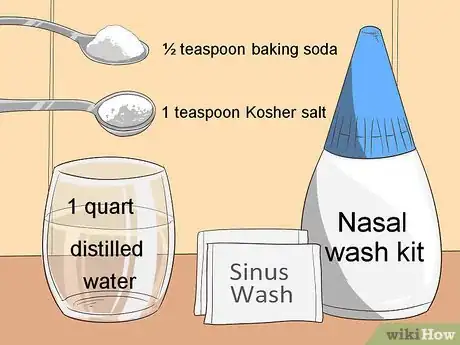
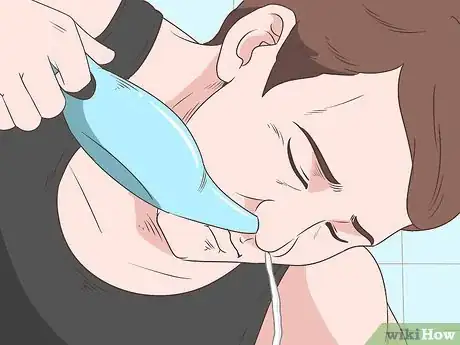
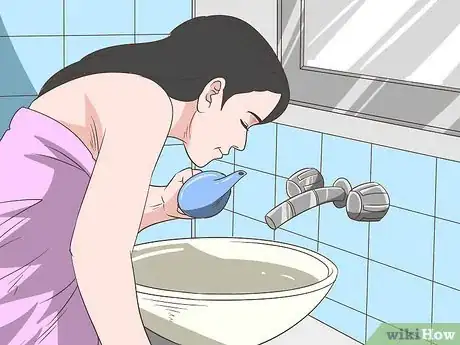
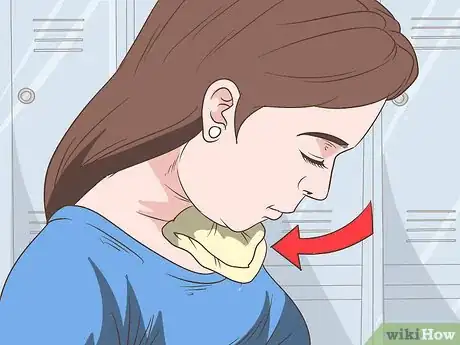
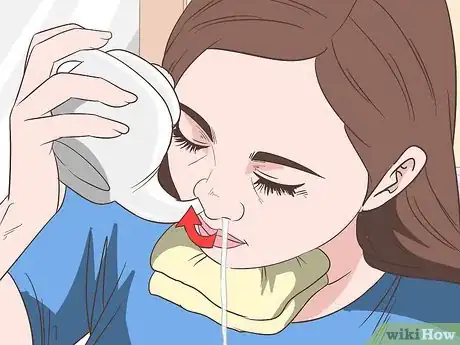
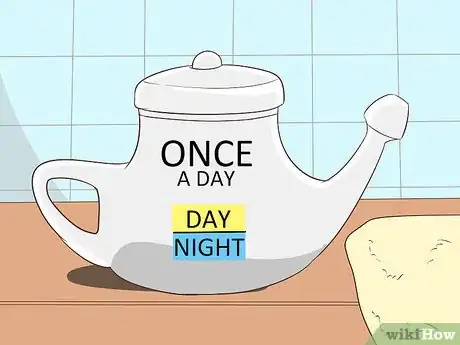
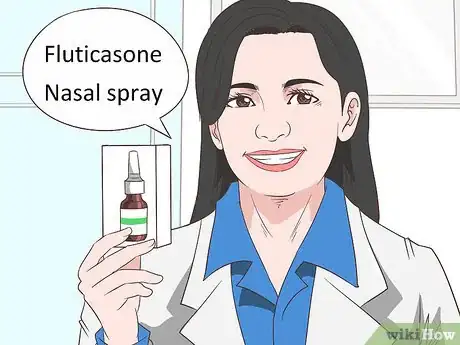
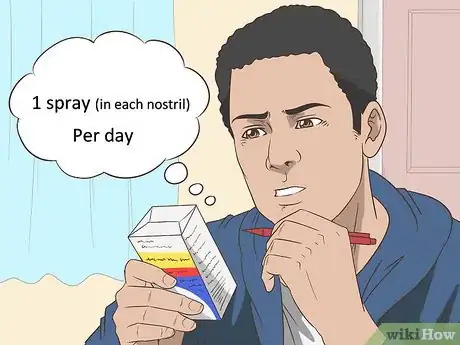
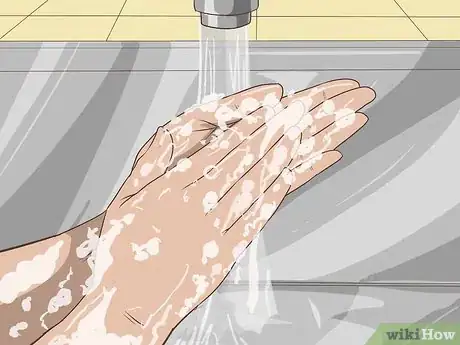
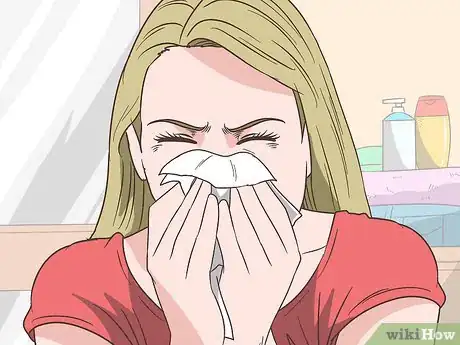
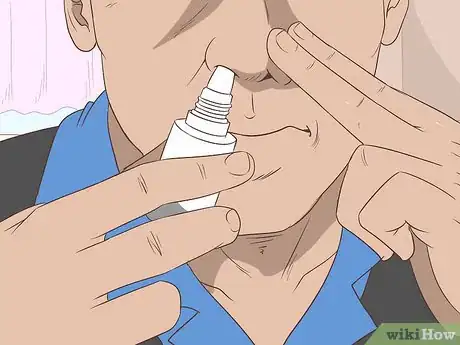
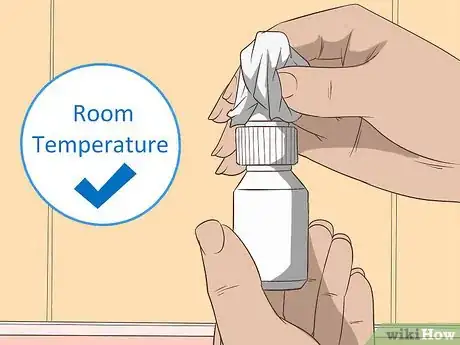
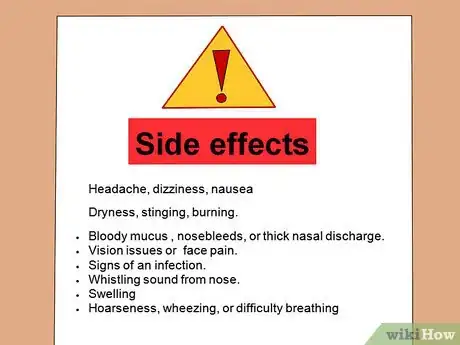

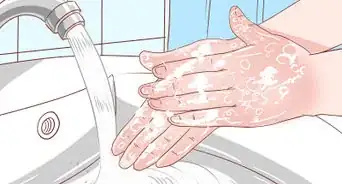
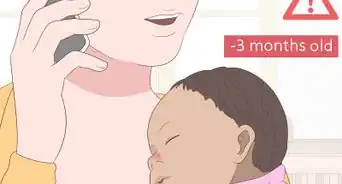
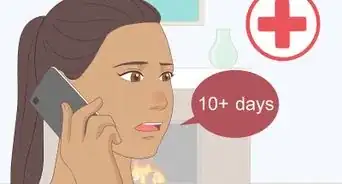
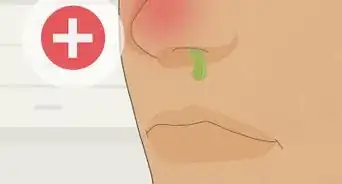
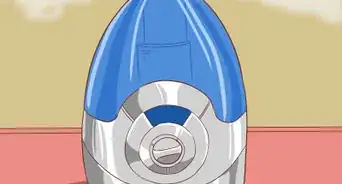
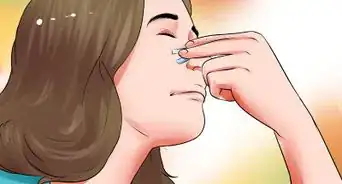

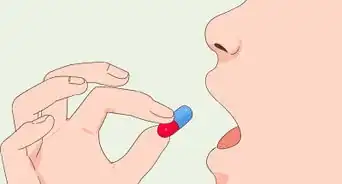

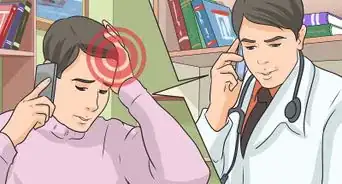
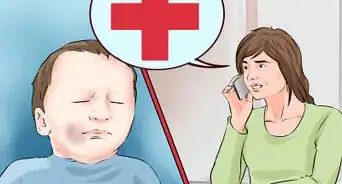

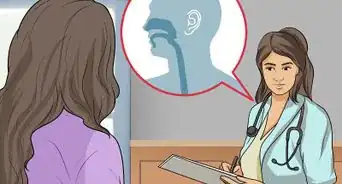












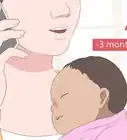
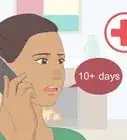



































Medical Disclaimer
The content of this article is not intended to be a substitute for professional medical advice, examination, diagnosis, or treatment. You should always contact your doctor or other qualified healthcare professional before starting, changing, or stopping any kind of health treatment.
Read More...